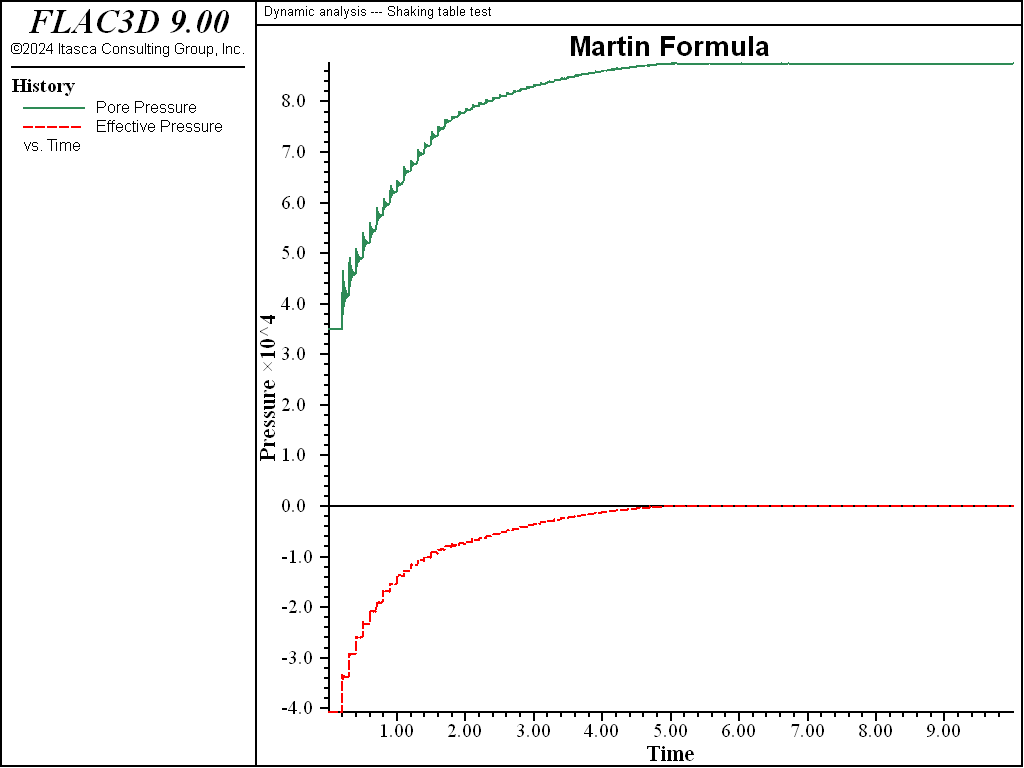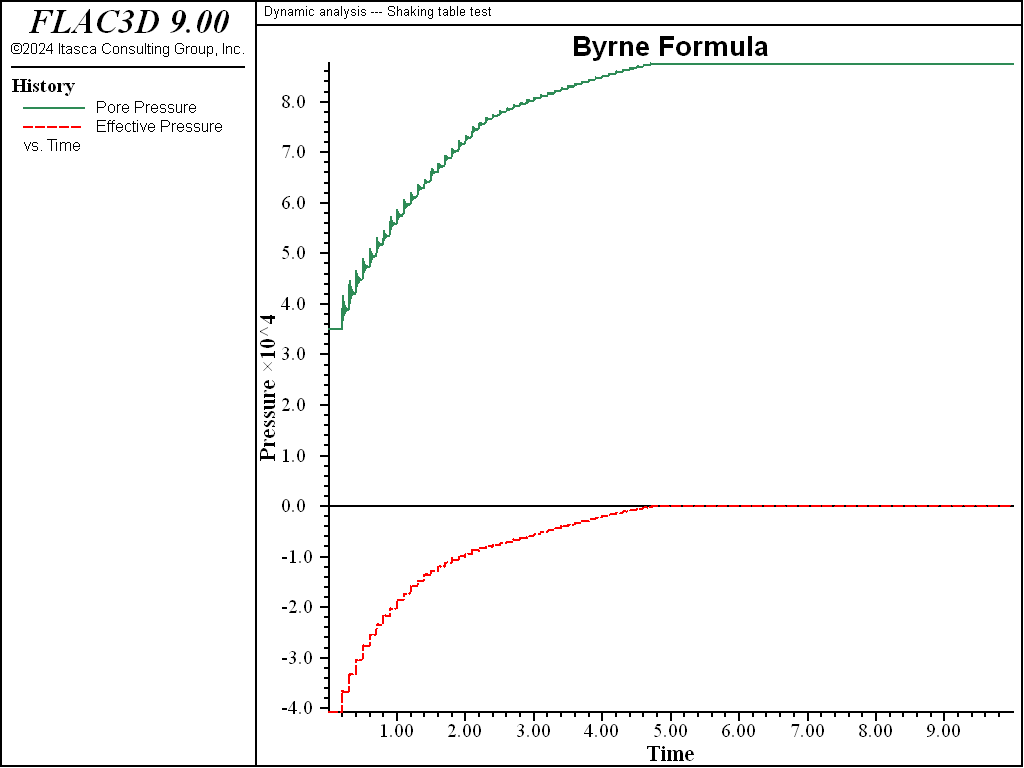Shaking Table Test with Finn Model: Simulation of the Liquefaction of a Layer
Note
To view this project in FLAC3D, use the menu command . The main data files used are shown at the end of this example. The remaining data files can be found in the project.
The material constants in the Finn model that control pore pressure build-up are related to the volumetric response in a drained test. However, if results are available for an undrained test, then the test itself may be modeled, and the material constants deduced by comparing the numerical results with the experimental observations. Some adjustment will be necessary before a match is found.
In the following example, a “shaking table” is modeled with FLAC3D.
In this simple example, a “shaking table” is modeled with FLAC3D —this consists of a box of sand that is given a periodic motion at its base. The motion of the sides follows that of the base, except that the amplitude diminishes to zero at the top (i.e., the motion is that of simple shear). Vertical loading is by gravity only. Equilibrium stresses and pore pressures are installed in the soil, and pore pressure and effective stress (mean total stress minus the pore pressure) are monitored in a zone within the soil. A column of only one zone-width is modeled, since the horizontal variation is of no particular interest here.
The test is run for both the Martin et al. (1975) formula and the Byrne (1991) formula. The Byrne parameters correspond to \({(N_1)_{60}}\) = 6, which was selected to produce results that match those based on the given Martin parameters.
The results based on the Martin formula are shown in Figure 1, and those based on the Byrne formula are shown in Figure 2. The figures indicate similar behavior using either formula. Both show how the pore pressure at location (25, 25, 2.5) builds up with time. The history of effective stress in the same zone is also shown. It can be seen that the effective stress reaches zero after about 15 cycles of shaking (2 seconds at 5 Hz). At this point, liquefaction can be said to occur. This test is strain-controlled in the shear direction. For a stress-controlled test, collapse would occur earlier, since strain cycles would start to increase in amplitude, thus generating more pore pressure.

Figure 1: Pore pressure (top) and effective stress (bottom) for shaking table, using Martin.

Figure 2: Pore pressure (top) and effective stress (bottom) for shaking table, using Byrne.
References
Byrne, P. “A Cyclic Shear-Volume Coupling and Pore-Pressure Model for Sand,” in Proceedings: Second International Conference on Recent Advances in Geotechnical Earthquake Engineering and Soil Dynamics (St. Louis, Missouri, March, 1991), Paper No. 1.24, 47-55 (1991).
Martin, G. R., W. D. L. Finn and H. B. Seed. “Fundamentals of Liquefaction Under Cyclic Loading,” J. Geotech., Div. ASCE, 101(GT5), 423-438 (1975).
Data File
ShakingTableTest.dat
;------------------------------------------------------------ ; Script file for dynamic problem ; Shaking table test ;------------------------------------------------------------ model new model large-strain off fish automatic-create off model title "Dynamic analysis --- Shaking table test" model configure dynamic fluid ; ; Create zones ; Martin grid zone create brick size 1,5,1 point 1 (50,0,0) point 2 (0,5,0) ... point 3 (0,0,5) group 'Martin' ; Byrne grid zone create brick size 1,5,1 point 0 (0,0,10) point 1 (50,0,10) ... point 2 (0,5,10) point 3 (0,0,15) group 'Byrne' ; ; Assign material model and properties zone cmodel finn zone fluid cmodel assign isotropic zone property density 2000 shear 2e8 bulk 3e8 friction 35 number-latency=50 ; Parameters for Martin formula zone property flag-switch=0 constant-1=0.80 constant-2=0.795 ... constant-3=0.45 constant-4=0.73 range group 'Martin' ; Parameters for Byrne formula fish define c1(n1_60) c1 = 8.7*math.exp(-1.25*math.ln(n1_60)) end zone property flag-switch=1 constant-1=[0.5*c1(6)] constant-2=[0.4/c1(6)] ... constant-3=0.0 range group 'Byrne' zone fluid property porosity 0.5 zone gridpoint initialize fluid-modulus 2e9 zone initialize fluid-density 1000 ; ; Boundary Conditions fish define sineWave(gp,dum) local v = 0.005 * math.sin(2 * math.pi * 5 * zone.dynamic.time.total) sineWave = v * (5 - gp.pos.y(gp)) / 5.0 end zone face apply velocity-x 1 fish-local sineWave ; Apply to all faces zone face apply velocity-normal 0 range position-y 0 zone gridpoint fix velocity-z ; ; Initial Conditions model gravity (0,-10,0) zone gridpoint initialize pore-pressure 5e4 gradient (0,-1e4,0) zone initialize-stresses ratio 0.8 total ; ; Dynamic setup zone dynamic damping rayleigh 0.05 20.0 ; ; Histories history interval 20 model history name='time' dynamic time-total zone history name='ppm' pore-pressure position (25,1.5, 2.5) zone history name='ppb' pore-pressure position (25,1.5,12.5) zone history name='esm' stress-effective quantity mean position (25,1.5, 2.5) zone history name='esb' stress-effective quantity mean position (25,1.5,12.5) zone history velocity-x position (0,5,0) model save 'initial' ; ; Solve to time 10 and save model fluid active off model solve time-total 10.0 model save 'ShakingTableTest'
| Was this helpful? ... | Itasca Software © 2024, Itasca | Updated: Nov 12, 2025 |
